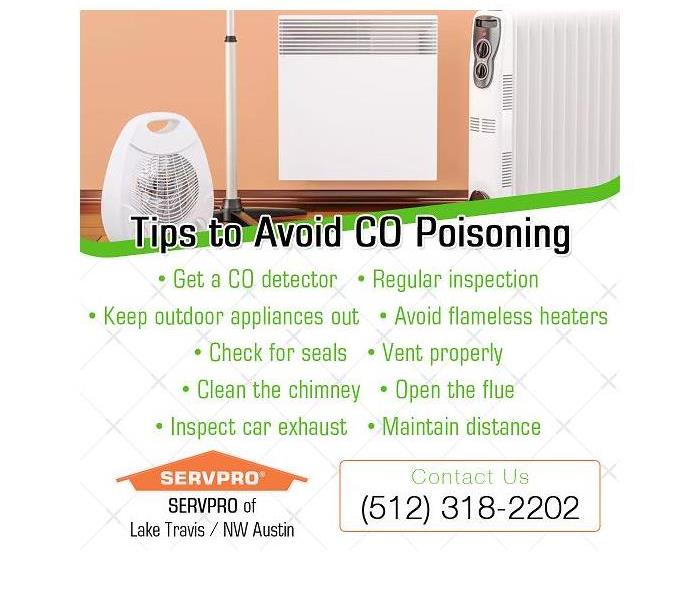SERVPRO: All About Carbon Monoxide Poisoning and Ways to Prevent It
7/21/2021 (Permalink)
Blog summary: The SERVPRO article gives insight into carbon monoxide poisoning and the preventive measures homeowners can take to prevent it.
Prevent carbon monoxide poisoning
As per statistics, at least 430 people die in the US every year due to accidental carbon monoxide (CO) poisoning. Approximately 50,000 people in the US land up in the emergency department every year due to accidental CO poisoning. SERVPRO explains below what is carbon monoxide poisoning, its impact on health, its causes, and the ways to prevent it.
What is carbon monoxide (CO)?
CO is an odorless, tasteless, and colorless gas that can cause severe health problems and even death. This deadly gas builds up in enclosed or partially closed spaces by burning fuel (gas, wood, propane, etc.) in various appliances and machines. These appliances include stoves, fireplaces, gas ranges, lawnmowers, electric generators, cars, and more.
How does CO affect health?
Human senses are generally unable to detect the presence of CO. Red blood cells pick up CO quicker than they pick up oxygen. Once the air is saturated with CO, the body starts replacing oxygen in blood with CO, resulting in damage to tissues and eventual death.
CO poisoning is a risk for all human beings and animals, but unborn babies, infants, and people with chronic heart disease, anemia, or respiratory problems are at maximum risk.
Symptoms of CO poisoning
Unless suspected, CO poisoning can be difficult to diagnose because the symptoms mimic other illnesses. Two factors determine the severity of carbon monoxide poisoning - concentration of carbon monoxide and the duration of exposure.
Low to moderate CO poisoning symptoms:
- Headache
- Fatigue
- Shortness of breath
- Nausea and dizziness
High levels of CO inhalation can cause:
- Mental confusion
- Vomiting
- Loss of muscular coordination
- Loss of consciousness
- Death
If CO poisoning is suspected, everyone must immediately move outside for fresh air and call 911.
What are the usual suspects for CO poisoning?
This toxic gas can originate from the most innocent and ordinary of sources.
Generally, any home appliance or piece of equipment that burns wood, propane, natural gas, oil, charcoal, or coal is potentially a source of carbon monoxide in the house. Some of these appliances and pieces of equipment are:
- Boilers
- Furnaces
- Fireplaces
- Water heaters
- Ovens and ranges
- Space heaters
- Wood-burning stoves
- Backup generators
- Propane and charcoal grills
- Cars and other automobiles
- Gas-powered lawn mowers
Preventive tips
- Get a CO detector: Install a CO detector and check and/or change the batteries in the CO detector every six months. Purchase a battery-powered or battery backup CO detector.
- Regular inspection: Get a certified professional to inspect and/or service the heating system, water heater, and any other gas, oil, or coal-burning appliances.
- Keep outdoor appliances out: Never use gas ranges or ovens to heat the house. Do not use gas camp stoves, hibachis, lanterns, or charcoal grills indoors.
- Avoid flameless heaters: Don’t use portable flameless chemical heaters (catalytic) indoors. They burn gas and can cause CO to build up.
- Check for seals: While purchasing gas equipment, look for the seal of a national testing agency like Underwriter’s Laboratories.
- Vent properly: Gas appliances must be vented properly.
- Indoor vent pipes should go up slightly as they go toward the outdoors.
- Never patch a vent pipe with tape, gum, or anything else.
- Keep the vents for the stove, fireplace, dryer, and furnace clear of debris and other blockages.
- Clean the chimney: Check the chimney for soot, debris, and corrosion at least once a year. Hire a chimney sweep to clean.
- Open the flue: When the fireplace is in use, open the flue. Put out the fire completely before closing the fireplace or damper.
- Inspect car exhaust: Never idle a vehicle inside a garage that’s attached to the house or living space. Get a mechanic to inspect the vehicle’s exhaust system once a year to prevent CO build-up.
- Maintain distance: Run a motor vehicle, generator, pressure washer, or any gasoline-powered engine at least 20 feet away from an open window, door, or vent where exhaust can’t vent into an enclosed area.
These preventive tips must be followed carefully to protect lives and homes. Homeowners can reach out to a professional team like SERVPRO that is experienced in fire damage restoration as well as soot and smoke removal.
Why SERVPRO?
- SERVPRO uses state-of-the-art equipment to bring the damaged property back to its original state. SERVPRO of Lake Travis/NW Austin is always updating its fleet and equipment so clients in Lake Travis/NW Austin, or anywhere else can quickly access the services.
- With over 1,700 US and Canadian Franchise locations, SERVPRO is strategically positioned to respond faster to an emergency of any magnitude.
- The SERVPRO staff is highly trained in property damage restoration. They receive initial in-house training and constant skill up-gradation at the corporate training facility and also acquire the regular IICRC-industry certification.
For fire damage restoration services in Spicewood and surrounding areas, call SERVPRO of Lake Travis/NW Austin today at (512) 318-2202.

 24/7 Emergency Service
24/7 Emergency Service
